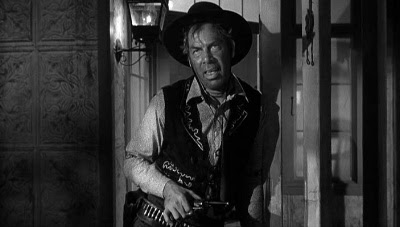 Point Blank
Point Blank (1967) and
High Plains Drifter (1973) both tell revenge tales where the underlying idea that the main character is dead becomes a plot device to drive the story. In each case, the "hero" returns to parcel out retribution to those who engineered his earthly demise. The difference between these two films is how these "dead men" go about it.
Point BlankBefore the opening credits, Walker (Lee Marvin), a criminal, is shot (point blank) and left for dead by his wife (Sharon Acker) and partner (John Vernon) after a heist that culminates at Alcatraz. Behind the main titles we see a grainy photo montage of Walker managing to pick himself up and climb over the prison fence to safety. How he's able to do this defies any rational explanation (other than this is some sort of dying man's fantasy).

The next scene shows Walker heading purposefully down a hallway, his quest now underway.
As he mercilessly torments his former associates, all he claims to be after is his share of the job, $93,000. But he seems to be after some other undefined something. Exactly what, I don't think he even knows. Answers perhaps.
To get his money, Walker has to work his way up the organized crime ladder. Each of the lower rungs he encounters are unable to meet his seemingly simple demands (apparently criminals have bureaucracy as well).
It's an interesting performance from Marvin. He's brutally tenacious when smacking people around. But, he's also very quiet and restrained much of the time.

One scene in particular stands out. While his wife tries to explain WHY she betrayed him, he just sits and listens without saying a word. As scripted, this scene was supposed to be two-way conversation, with both characters talking. However, Marvin wanted to try it with just the wife reciting her dialog EXACTLY as written and he reacting without talking at all.
I get the impression that Walker ultimately blames himself for his fate. Sure, lots of people did him wrong. But HE was the one who put himself there.
At the film's end, his goal within reach, Walker drifts away with an air of quiet resignation.
High Plains DrifterThe man with no name, literally in this case, played by Clint Eastwood (who also directed) shows up in Lago, a community with a terrible secret.
A while ago, they did nothing while a trio of outlaws whipped a marshall to death right in the center of town.
 I have the hardest time convincing many of my friends that Eastwood is supposed to be that dead marshall. Many contend that it's the marshall's brother who comes a calling (this theory doesn't quite explain how the stranger could have found out about his "brother's" death).
I have the hardest time convincing many of my friends that Eastwood is supposed to be that dead marshall. Many contend that it's the marshall's brother who comes a calling (this theory doesn't quite explain how the stranger could have found out about his "brother's" death).
But Eastwood's first appearance should be enough to settle the matter. There's a long shot across the desert. In the distance, the sun creates a wavy heat pattern. Suddenly, a rider appears out of thin air and emerges from that heat pattern.
I don't know what could be more clear.
Unlike Walker, this stranger is not only going to get his pound of flesh, he wants to have fun doing it. As far as he's concerned, EVERYONE was culpable. And, indeed, everyone ends up paying. Of course, those in the town who are more "guilty" pay extra.
Perhaps the difference between Walker and the stranger, is that the stranger didn't do anything to deserve the fate he was dealt. So, his indignation is justifiably more severe.
Like many Westerns, once justice is served, the stranger rides away. The last shot, from a distance, shows the stranger disappearing into the same heat pattern from which he first emerged.
Again, how much clearer could that be?
Read more!
 Whenever you see your doctor or dentist wash his or her hands before an exam, thank Ignaz Semmelweis.
Whenever you see your doctor or dentist wash his or her hands before an exam, thank Ignaz Semmelweis.














































 Ann Coulter is her own worst enemy.
Ann Coulter is her own worst enemy.



